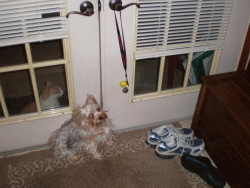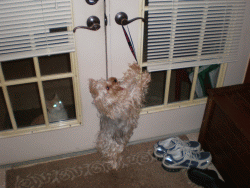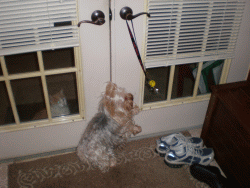How to Housebreak Your New PuppyFirst Things FirstLet me just say right from the start, housebreaking a dog can be one of the most trying tasks I can think of. I just don't get it. For some dogs, this is one of the easiest things for them to learn. However, there are just as many dogs on the other end of the spectrum that can bring you to the breaking point. Sometimes you wonder if they will ever understand what you are trying to teach them. But have patience my friend, they will get it - eventually. Much of the success of the housebreaking process rests on your shoulders. In my opinion, housebreaking a dog is best done with a young puppy. The process takes diligence and patience. It also takes a compassionate, understanding heart, if you expect to walk out of this with loyalty and respect from your dog. This is one of those learning seasons that can make or break the relationship you have with your new pet. The first thing you have to understand is that your dog wants to please you, but he also has to understand what it is that you are wanting him to learn. This may seem obvious to you (especially after the first 100 times), but apparently, it's not so obvious to him - yet. Be understanding. I have seen people absolutely terrify a dog over this housebreaking ordeal - to the point where the dog cowers at the owner's presence when they walk into the room. This kind of behaviour from you can lead to harsh and mixed signals to the dog. You are the one they are supposed to rely on, the one they are to trust with all their heart. You are their safe haven. If this trust breaks down, you may find that you indeed have an obedient dog, but you may have lost a dear friend. Use the Crate Luke (in the words of Obi-Wan Kenobi)If you have read my article on Crate Training, then you will know that I am a big fan of the crate. Crate training a dog is good for many reasons and carries many benefits. One of which is that it is a place where you can put him to take naps (and then you can take one too). Puppies need frequent naps and you will soon see that they take them liberally. If you are following my suggestions about crate training, then you are putting little Rover down for a nap several times a day, whether he wants to or not. Dogs learn best by repitition and here is one repetitive action that you can use in your favor. When it's nap time, always take him outside to give him the opportunity to do his business before you put him to bed. Also, as soon as he wakes up from his nap, or when you decide to let him out of the crate, he needs to be taken out. You should always take him out the same way. You should let him see how you are getting to the door, so that this path becomes a repetitive path that is engrained in his mind. You want to make sure he knows how to find the door. Create the Verbal LinkWhen you get him outside, you should take him to the same spot each time. You also need to come up with a phrase that he can associate with what he is doing - a verbal link that will help his mind trigger on what you are wanting him to do. We have two of them and they are quite simple. "Jasper - go Tee Tee" and "Jasper - be still and go Poo Poo". The "be still" part was added by my wife because Jasper tends to do a lot of trotting around when he's trying to find the perfect place to do his business. The wonderful thing is that he knows just what each phrase means, and when he hears them he will usually do them on command (he has been known to fake it though, just to get us off his back). Learning to go on command takes time. It took Jasper many months for all this to click in, but he got it. Jasper is an inside dog. The only time that he is allowed outside is to use the bathroom, or to go for walks. So, he know that when he is put on his runner, it is usually for one reason - to go to the bathroom. Sometimes we will leave him on it for a while to run a little, or enjoy the outdoors, but he knows that the first item of business is to use the bathroom. I suggest that until your dog is housebroken, you don't mix the two together. Go outside to play, or go outside to go to the bathroom, but not both together. Use the commands, or your keywords you've chosen for this action. When he's through, praise him like you never have before. I mean make a big deal out of it. Let him know that this made you very happy and so very proud of him, then bring him back inside. It will be easier for him to understand that going to the bathroom is an outdoor function, if that's all he's allowed to do out there. Don't worry, there's plenty of life left for outdoor playing after we master housebreaking. AnticipateThere are a few other key times that you should take him out. First, always take him out after ya'll have been playing. One of the by-products of work and playfull activity is water, and a young puppy can work it up quickly. For young puppies, a good 5 to 10 minute play is usually good enough to earn a trip outdoors. Another time is right after he has eaten. For most dogs, the added pressure of a good meal on his tummy is already pushing his previous meal out within minutes of finishing. You should be aware of these times and anticipate his next move. At the beginning of this process, you need to be thinking ahead. Pick him up after he's eaten, or stop the playing and take him out. This anticipation helps set him up for success. When you're first starting the house breaking process, don't wait on him to tell you when he needs to go outside. Help him out by anticipating these times. Sometimes the urges come too fast for the little fella, and then it's too late. This failure is your fault. If it happens, don't yell at him, just move him on outside, clean it up, and get over it. Pay Attention to HimAs time goes on, you will begin to understand your little dog more and more. As he begins to understand the outdoor concept he will no doubt be trying to convey this information to you. Some dogs will go to the door, others my begin to wander aimlessly around the room. Jasper will sometimes get up on my lap and touch his nose to mine. Other dogs whine, and still some others may just stop and stare at you. Pay close attention to him and I'm sure you will pick up on this communication. Be sure to give him the benefit of the doubt. If you've just put him in his crate and he starts to whine or bark. Take him outside. He may not have to go, but the one thing it teaches him is that you are aware of his signals. Now, if after the third time in 5 minutes, you've taken him out and he still has'nt done anything, then you may ignore him - he probably just wants to come out. But go through the motions the first few times to give him the opportunity just in case. Ring Your BellThis is my farvorite house breaking method, and well worth the training. We have made a way for Jasper to let us know when he has to go outside. We have a couple of bells attached to a strap hanging from the back door knob, and we've taught him to ring it whenever he wants to go outside. This works like a charm. We'll be sitting in the livingroom watching TV, then all of a sudden we'll hear the bells jingle just a little - we kinow what it means - it's either Jasper, or one of the cats (they do it too) wanting to go outside. It first starts with a little jingle, then if we wait too long, he really starts wacking at it. This is the greatest thing we've taught him. What's good too is that if we go somewhere, we just bring the bells with us. All we have to do is show him what door the bells are hanging from and he takes care of the rest.  Bell training takes some time but it's really not that hard. There must be some reward involved in it for him to get the ball rolling. We have some very small, dry, dog treats that we use for this, and we only use half of one. First, when it's time to take him out, we'll carry him to the door. Then we'll say "ring your bell" and take his little paws and let them make the bells jingle. Then we praise him, give him the treat, and then take him outside.
 After a while(a long, long, while) he will start to associate that ringing the bell is his que to you to get up and let him out. Sometimes, he sits and looks at us and we'll say "do you need to ring your bell?" and he'll tear out to the door and ring the bells. I always reward him with a half a treat for this. I don't want to ruin a good thing, and this is the best. We make up these training bells and instructions, along with a starter bag of treats. Please see our Yorkie Box Products page for information on how to order our House Breaking Training kit for your dog, or leave us your email address on our Feedback link and we will contact you with the details. Be PatientHouse breaking takes time so be patient. Most likely, this is not one of those tricks that you can teach your dog in a couple of sfternoons. I'm sure you want to get to the point where you can trust your dog to wander around the house by himself, right? Well, to tell you the truth, this may takes months. I've read one trainers guide where he won't let the dog out of his sight unattended within the first year. In fact, according to his guide, any mistake he makes in the house within the first year is your fault. I whole heartedly agree with him. You are going to have to follow him around (or keep him with you) so that you can catch him when about to make a mistake. This is the only way to actively guide him. He has to associate that function with going outside. And he has to know that you don't approve of him going inside. When you see him about to releave himself on your nice carpit, sound the alarm. It's okay to raise your voice. Tell him "No, No, No", then pick him up and take him outside. Don't beat him and scream - yet. There may come a time when he needs some harsher scolding, but not yet. I wouldn't resort to that type of action for many months. He first needs to know that it is wrong, and he needs to know it well before you start spanking him. When and if the time should come, then let your bark be bigger than your bite. Maybe a few pops to his rear end and more than normal yelling should be adequit. Believe me, he will get the picture that you are not pleased and he will try to make the proper correction. Last ThingsHere are a few Do's and Don'ts to keep in mind during the process. Do's
Don'ts
In conclusion, be consistent, be understanding, and above all, be patient. As I said in the beginning, housebreaking can be one of the most trying tasks you and your dog face, but remember to face the task together. It may take some time, but you can use this training event to be one that will help solidify the bond between you and your dog. |
|
|
|
 Now,
as I've said before, repetition is the key. On top of doing
this
at all the normal "going outside" times, I set aside a few 2 to 4
minute training sessions per day to teach him to ring his bell for a
treat. I start at the bell and teach him to hit the bell for
a
treat. Then we will start at further distances from the bell.
First getting him to run and ring the bell from 3 feet away,
and
then further distances, until he will ring the bell on command from
anywhere in the room (for a treat of course).
Then, when he can do that, I start withholding the treat
until I take him outside - then I give him the treat.
Now,
as I've said before, repetition is the key. On top of doing
this
at all the normal "going outside" times, I set aside a few 2 to 4
minute training sessions per day to teach him to ring his bell for a
treat. I start at the bell and teach him to hit the bell for
a
treat. Then we will start at further distances from the bell.
First getting him to run and ring the bell from 3 feet away,
and
then further distances, until he will ring the bell on command from
anywhere in the room (for a treat of course).
Then, when he can do that, I start withholding the treat
until I take him outside - then I give him the treat.
